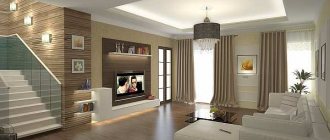Standard ceiling heights
The main regulatory document regulating the height of ceilings in apartment buildings is SNiP 31-01-2003, according to which the parameter in question depends on:
- Climatic conditions in a particular area;
- Purpose and type of room.
Climatic region is a parameter that takes into account the average temperature profile for each month, as well as the level of humidity and wind direction. According to SNiP 01/23/99, there are four districts divided into 16 zones. The zones are arranged in descending order - the higher the category, the milder the climate in this zone.
According to the standard, in the warmest zones the ceiling must be at a height of at least 2.7 meters, and for other areas the minimum ceiling height is 2.5 meters. These parameters are not formed out of the blue - complex calculations show that ensuring a normal microclimate and air exchange in rooms is possible only if the actual parameters correspond to the nominal ones.
In rooms located in the attic, the ceiling can be lowered, but the amount of reduction is also regulated - the ceiling level can deviate from the standards only over half the area of the room. In passage rooms (for example, corridors), the ceiling height according to GOST can be reduced to 2.1 m - this figure will be quite sufficient for the normal movement of people.
The maximum ceiling height is not specified by regulatory documents, but in practice the ceiling is rarely raised above 3.2 meters. In older buildings, the size of the rooms can be increased, as a result of which the ceiling height can exceed 4 meters.
When arranging your home yourself, you need to choose the ceiling height taking into account the parameters described above and the area of the premises. For example, for small and narrow rooms it is not recommended to use high ceilings - they will create a rather unpleasant feeling. In large rooms, this rule works in the opposite direction - for a large hall, a ceiling over 3 meters high is optimal.
"Stalin" and older houses
Older buildings traditionally did not skimp on space, so the area and height of each individual room was quite large. The thing is that the historical period in which such houses were built was not characterized by the desire to provide all families with at least a small apartment.
The ceiling height standards in "Stalinka" buildings vary from 3.3 to 3.6 m, while the ceilings themselves are usually decorated with various decorative elements - for example, stucco molding or cornices. When installing suspended ceilings in such apartments, due to the large amount of finishing, it is necessary to significantly reduce their level.
Certain difficulties also arise due to the fact that wooden elements were often used to make floors in old houses, and the wiring was laid externally - repairing the ceiling in such conditions is not very easy, so you have to invest much more money in repairs.
However, an increased amount of free space has its advantages - in a tall room with a large area, you can arrange any style, and it will look quite appropriate. An excellent option, for example, would be a multi-level suspended ceiling, decorated with a variety of decorative elements.
Suspended ceilings of any configuration are generally very suitable for rooms with a high ceiling height - the availability of space allows you to painlessly reduce the volume of the room. Finishing the very basic ceiling in such rooms would be a bad decision - the existing ceilings usually have a lot of “congenital” defects, which are very difficult to hide.
How to adjust a room if the ceiling is low
The parameters of the room should be such that it is pleasant to be in it. For example, in a high and narrow room a person may feel uncomfortable because he will have the impression that he is in a well. There are several important parameters that would help ensure this comfort.
Visual techniques
There are many ways to elevate it using the right materials, colors and design techniques.
Mirror surfaces
Nothing will help visually enlarge a space like a mirror. However, we do not recommend getting carried away and covering all surfaces with mirrors; this will simply make the space uncomfortable. Try combining ceiling tiles with mirrored or highly reflective glossy inserts.
Color
Here, follow the rule that the ceiling surface is lighter than the walls. For small rooms, light pastel shades are well suited; they not only refresh the appearance of the room, but also visually expand it.
Pexels
Another little trick: think through your interior so that the colors gradually lighten as they rise from the floor to the top. For example, from a dark gray floor there is a transition upward to cool white.
Wallpaper
Here you need to try to find a wall covering with a vertical pattern. These can be stripes, floral patterns or painted branches. Give preference to light tones of wallpaper with a slight shine.
Try experimenting with a matte texture on the walls and a glossy texture on the top floor. In this case, the color of the surfaces must be the same. It is worth noting that if your ceiling height in your apartment is only 250 centimeters, then we recommend forgetting about decorative borders and baseboards. They tend to delimit space, thereby shortening it.
Interior items
It’s worth paying attention to the furniture, because correctly placed accessories, just like materials, affect the visual perception of the room. Install tall shelving and cabinets. This will become a significant accent that will stretch the room. Also choose sofas and armchairs with low backs.
Unsplash
Little things matter too. Place thin vases, small trees, folds in curtains on the shelves - all this stretches the vertical of the room and helps to raise even a low ceiling.
Little things matter too. Place thin vases, small trees, folds in curtains on the shelves - all this stretches the vertical of the room and helps to raise even a low ceiling.
Tips for creating a pleasant atmosphere
Microclimate
Humidity and temperature should be comfortable and pleasant.
- Cleaning
9 rules for a healthy microclimate in your home
Lighting
There should be a lot of light in the room, be it natural or artificial lighting. It’s better to have a lot of light elements that can be turned off and on if necessary.
Ventilation
The supply of fresh air is a very important element that affects the comfort of staying in the apartment.
"Khrushchev"
During the reign of Khrushchev, serious changes occurred in the construction industry. Thus, the main task set for the developers was to provide all families with their own housing. Of course, with such introductory housing, it was necessary to seriously reduce the housing, and the result of the design work was the “Khrushchev” - apartments with a very modest area and minimal ceiling height.
In classical apartments of the period under review, the ceiling was 2.5 m from the floor level. Individual apartments located on the first or last floor could have ceilings 0.1 m higher than the designated indicator. In the northern regions, the height from floor to ceiling in an apartment could reach 2.7 m.
For the manufacture of interfloor ceilings in Khrushchev-era buildings, reinforced concrete panels were used, which are easy to construct, quite reliable in operation and can be faced without problems. Accordingly, finishing ceilings usually came down to processing the joints in the slabs and applying whitewash.
Stretch ceilings, despite the reduction in ceiling height (even the simplest structures “eat up” about 5 cm), are used quite often in Khrushchev-era buildings. Lath or plasterboard structures are much less common - they require much more space to install. There is no need to talk about multi-level structures - they are completely inappropriate in such conditions.
By installing a suspended ceiling, you can try to compensate for the loss of free space by visually expanding the room. To achieve this effect, you need to very wisely select the colors and texture of the ceiling structure. It is better to use spotlights as lighting devices - installing large chandeliers in Khrushchev buildings is completely impractical.
How to correctly calculate ceiling height
In addition to the standard value, regulated by relevant documents, when choosing an apartment for living or in the construction of a private house, the optimal value of the ceiling height, which is convenient, should also be taken into account. It depends on: the size of the room. If it is a large room, this value can be from 3.5 m, in the case of a kitchen or dining room with an area of 20 m² - 2.8 m. This method of determining the optimal height is only suitable for a private house, when you can draw a design before it is built. Even though the cost of multi-level construction will be more expensive, it will be much more convenient.
The remaining distance from the floor covering to the construction of the ceiling after repair. For example, assembling tiled and suspended structures along with full heating in an apartment can strip them of up to 20 cm in height.
"Brezhnevki"
After some time, when Brezhnev came to power, along with him came the desire of people to live in more comfortable conditions. This desire is reflected in state building regulations. Thus, the standard ceiling height in an apartment has increased to 2.6-2.7 m, and the rooms themselves have become larger. In addition, standard designs were supplemented with separate hallways, as well as built-in wardrobes and mezzanines. There were no other differences from the apartments of the Khrushchev era - all the same brick walls, panel ceilings, simplified layout and complete absence of any decoration.
Brezhnevkas are quite convenient in terms of repair. The ceilings in such apartments are simple and fairly flat, which allows you to use any available materials and solutions for finishing. The difference between the base ceiling and the minimum possible is about 15 cm - and this distance is quite enough for both simple finishing and for arranging suspended structures.
We are planning renovations in an apartment with a low ceiling
When doing global renovations, you need to know what the standard ceiling height is in your apartment. This figure is needed in order to properly plan the future interior. After all, even by laying laminate floors and making suspended ceilings, you will significantly reduce the distance from the floor. A few centimeters may not matter, but if you have a low ceiling, every extra centimeter will have to be fought for.
Unfortunately, if the ceiling in your apartment does not exceed 2.5 meters, you will probably have to abandon plasterboard suspended ceilings, because such a ceiling can “steal” more than 10 cm in height. For the same reason, multi-level ceilings are not suitable.
Buildings made of panels and blocks
Initially, panel houses were built under Khrushchev. The standard configuration of such houses assumed that they would have five floors, and they would be built in the southern regions. The standard ceiling height in panel houses was about 2.5 meters, and the walls were built of brick. By and large, these buildings were very similar to typical “Khrushchev” buildings - there was little free space, and there was not enough natural light even on sunny days.
Renovation of houses made of panels and blocks occurred already in the 80s. The new buildings were distinguished by an increased number of floors, large area of premises and high ceilings - their minimum height was 2.65 m, and in some cases reached 2.75 m. Even with a superficial examination, we can safely say that such apartments were much more convenient.
This convenience was evident not only during the operation of the apartments, but also during renovations. Thus, finishing the ceiling was extremely simple - initially the surface of the floors was flat, so it could be arranged in any way. The high ceilings typical of such apartments made it possible to use suspended and suspended ceiling structures.
The most noticeable disadvantage of panel houses is the low level of sound and noise insulation. That is why during renovations it is always necessary to use high-quality materials to reduce the noise level entering the apartment from the outside.
Norms and rules for different rooms
If we talk about the standards provided for in individual premises, we can divide them into several categories.
For living rooms and kitchens
The length of the vertical walls should be no less than the height of the tallest family member plus one meter. The upper layers of air always contain a lot of bacteria and dust, so such parameters will provide not only convenience, but also good well-being.
In the hall and hallway
If there are mezzanines, the optimal distance from the floor to the structure is more than 210 centimeters.
Private house with attic
The minimum distance to the ceiling in a private residential building with an attic can be at least 140 centimeters. It is worth noting that this only applies to the room under the roof, where the walls are connected to the floors.
In non-residential premises
For example, such as a bathhouse or a garage, a large distance from the floor simply does not make sense.
Modern apartments
Today, apartments and premises in multi-storey buildings have a variety of layouts, and modern technologies are used in the construction process. Due to this, a fairly wide variability in the dimensions of the premises is ensured - for example, the height of the ceilings in the office can completely “float” depending on the purpose of a particular room. Diversity allows you to choose apartments in a wide range of prices - with a minimum budget you will have to choose among economy-class apartments, and the ability to invest more money allows you to purchase housing that will have a larger area and a high degree of comfort.
The difference between cheap and expensive apartments is obvious:
- When building small apartments and studios, the priority goal is the minimum cost of finished housing. One of the ways to save on materials is to limit the height of the ceiling, so the standard ceiling height in new buildings is usually the minimum allowable 2.7 m. The ceiling itself in such conditions lends itself to any finishing work - the only limitation is multi-level suspended structures, which are undesirable to install in small rooms . The optimal solution would be to use finishing materials that allow you to visually expand the space.
- For the construction of expensive apartments, individual projects are usually used, and the ceiling height in new buildings can vary from 2.8 to 3.2 m. The purchase of luxury housing usually indicates the good financial capabilities of the buyer, so all repair and finishing work in this case is entrusted to the appropriate specialists. A competent designer will calculate the optimal ceiling height for a specific project, which will fit perfectly into the planned style.
Ergonomics of living space
This science determines the optimal ceiling height to make the room feel as comfortable as possible.
To create comfortable conditions, builders must comply with certain ergonomic conditions:
- provide sufficient natural light;
- create an environment with optimal humidity and oxygen levels.
The indicators will vary depending on the area and purpose of the room, but the height of the standard ceiling in the room will help achieve all this.
Private houses
In the case of private houses, everything is somewhat different than with apartments. When building apartment buildings, developers have to take into account the fact that there will be many apartments in one building, and each of them needs to be made quite comfortable - i.e. certain restrictions are introduced. For private houses, such restrictions are irrelevant - the dimensions of the premises are practically independent of external factors.
For a comfortable stay in a private house, you need to raise the ceiling to a level of about 2.9-3.2 m. Of course, these figures can be increased even more, but this is impractical - the free space will not be in demand, and heating costs due to the increase the volume of the room will increase. In warm regions, this point can be ignored, but for the middle zone and northern regions it is more than relevant.
The selection of finishing materials for the ceiling directly depends on how the floors were formed:
- In the case of wooden beams, tensile and suspended structures are best, as well as wood cladding and materials that allow the beams to remain visible;
- Absolutely all finishing materials are suitable for reinforced concrete floors.
Ceiling height calculation
It’s worth noting right away that the height of the ceiling in a living space and its decoration are two closely related parameters, and each of them depends on the other. For this reason, before calculating the height of the ceiling, you need to decide what finishing materials will be used in the structure. Knowing this parameter will significantly simplify the calculation of the ceiling height, especially if systems consisting of several levels will be mounted on it.
The standard ceiling height in an apartment is a fairly clear parameter, and for each of the existing types of housing it was described above. But, in addition to this parameter, there is also an optimal ceiling height, which always exceeds the standard or coincides with it. Calculation of the optimal height is aimed at ensuring that each room is as comfortable as possible and looks harmonious.
When choosing the optimal ceiling height, it is worth considering the following number of factors:
- In residential premises and kitchens, the minimum height of ceilings in an apartment after all work must exceed the height of the tallest family member by 1 m. This indicator was not derived by chance - studies have shown that the highest content of various harmful impurities of household origin is observed at this height. To eliminate the impact of these impurities on the body, you need to raise the ceiling level in accordance with the specified rule.
- Making ceilings that are too high is not practical from an economic point of view. For example, if in a building with an area of 100 m2 the ceiling is raised by 30 cm, then the total volume of the house will be increased by 30 m3 - and this volume will not be useful, and a significant amount will be spent on heating it.
- In multi-storey private houses, high ceilings are not recommended. Firstly, this will lead to an increase in the cost of heating and the cost of building a house. Secondly, if there are two or more floors, it is necessary to equip a staircase - and if the ceiling is too high, it will be located at a large angle, and because of this it will not be possible to walk comfortably on it. To make a large and spacious room, it would be better to plan the house so that there is no ceiling above this room at all.
- In non-residential and utility premises, a high ceiling is completely unnecessary. In a closet, small hallway or garage, the ceiling height may be below the minimum. Typically, for such premises, values of 2.2-2.5 meters are used. In bathhouses and saunas, the ceiling rarely rises above 2.2-2.3 m - when this value increases, it becomes much more difficult to heat the room.
- There is a direct relationship between the area of the room and the height of the ceiling in it - the larger the room, the better the high ceiling will look in it. To ensure that the ceiling height in the apartment corresponds to the area of the premises, you can use various finishing methods that change the height of the structure - for example, suspended or stretch ceilings. Such systems, among other things, also allow you to hide all communications.
How to adjust a room if the ceiling is high
Surprisingly, this is sometimes necessary. For example, in small rooms, high walls create the feeling of a well. And I want to avoid this. We recommend several working methods.
Multi-level
With the help of various protrusions, steps, convex parts and inserts, you can give the room not only an interesting and original look, but also reduce the space a little.
Tensile structure
Pexels
This method is not recommended for apartments where the vertical length of the walls is only 2.5 meters. The reason is simple: the structure is made with an indentation from the ceiling at a distance of 5-20 centimeters, since communications and sound insulation are located inside it. But for high ceilings and small rooms it is a good solution.
Plasterboard structures
This type also requires a setback from the main floor, which means it reduces the height. First, determine the degree of curvature of the surface of the concrete slabs. A ledge is made on top along the perimeter of the room, and LED lighting is placed under it. Pay special attention to it, since in the future it will be important what size the lamps are and the amount of wiring. Sufficient space must be provided for convenient installation and subsequent operation. Another aspect will be the shape itself. Drywall can be used to give the top floor a lot of interesting shapes. Therefore, design the number of levels in advance.
However, you need to be careful with this method so as not to make it even worse - the design can take away from 15 to 20 centimeters.
Pixabay
Or, as another interesting option, make a glossy or mirror insert in the middle, where there is no structural box. Thus, in contrast with the protrusion, this element will appear higher, and due to the reflection of light, the space will visually increase.











